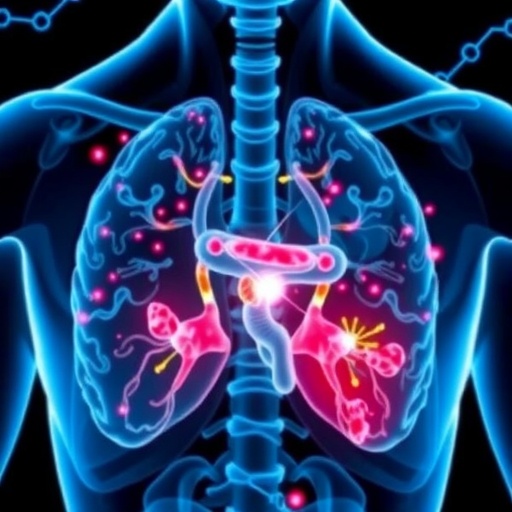In a groundbreaking advance poised to redefine therapeutic strategies for neuroendocrine prostate cancer (NEPC), researchers have unveiled the pivotal role of modulating endoplasmic reticulum (ER) stress and nitroso-redox imbalance through the targeted use of nitric oxide (NO). This new study, published in Cell Death Discovery on November 6, 2025, casts light on the intricate molecular interplay that drives NEPC progression and positions nitric oxide as a potential therapeutic agent, offering renewed hope for one of the most aggressive and treatment-resistant prostate cancer subtypes.
NEPC is notorious in oncology for its rapid progression, resistance to conventional androgen deprivation therapies, and a poor prognosis compared to typical prostate adenocarcinomas. Researchers have long struggled to decipher the molecular underpinnings of NEPC, which diverges significantly from its androgen-dependent counterparts. Central to the novel insights presented is the role of cellular stress mechanisms, specifically those emanating from the endoplasmic reticulum, and their crosstalk with the cellular redox environment, which together create a hostile tumor microenvironment conducive to malignant transformation.
The endoplasmic reticulum, a key organelle responsible for proper protein folding and intracellular calcium homeostasis, becomes burdened under conditions of persistent stress, triggering what is known as the unfolded protein response (UPR). This adaptive pathway, when chronically activated, can paradoxically escalate survival signals for cancer cells, allowing them to thrive under conditions that would normally induce cell death. The study meticulously delineates how this ER stress response is intricately linked with alterations in redox signaling, specifically via nitroso-redox imbalance, which exacerbates tumor growth and dissemination in NEPC.
Nitroso-redox imbalance refers to the dysregulation of nitric oxide and reactive oxygen species within the cellular milieu, a phenomenon that has garnered increasing attention due to its dual role in cellular signaling and oxidative damage. Tumor cells exploit this imbalance to evade apoptosis and modulate the immune response, thereby securing a microenvironment that favors unchecked proliferation. The research team has demonstrated that NEPC tumors exhibit pronounced nitroso-redox disequilibrium, underpinning their aggressive phenotype.
Addressing this pathological nexus, the study explores nitric oxide—not merely as a biomolecule with vasodilatory function but as a versatile mediator capable of restoring cellular homeostasis. The authors present compelling evidence that carefully modulated nitric oxide donors can rectify ER stress markers and rebalance the nitroso-redox state in NEPC cells, culminating in suppressed tumor growth and enhanced susceptibility to apoptosis. This dual mechanism represents an elegant therapeutic strategy that simultaneously undermines two cancer-promoting processes.
What sets this study apart is the comprehensive mechanistic approach the researchers adopted. Utilizing advanced molecular biology techniques, they tracked the response of key UPR transducers like PERK, IRE1α, and ATF6 under nitric oxide treatment, revealing attenuated signaling pathways associated with cancer cell survival. Parallel assays quantified shifts in reactive oxygen and nitrogen species, confirming restoration of redox equilibrium. These findings underscore a precise, targeted intervention, as opposed to blanket antioxidant therapies that have previously failed in clinical trials.
The implications extend beyond NEPC itself, as ER stress and nitroso-redox imbalance are pervasive themes in various malignancies. By establishing a direct link between nitric oxide modulation and tumor microenvironment normalization, this research paves the way for broader application of similar strategies across cancer types that share these pathogenic features. It invites a reevaluation of nitric oxide’s role in oncology, potentially repositioning it from a background player to a cornerstone of emerging therapeutic regimens.
Moreover, the therapeutic potential of nitric oxide is enhanced by its inherent biochemical versatility and the availability of diverse nitric oxide donors that can be fine-tuned for targeted delivery. The study hints at the feasibility of designing combination therapies that integrate nitric oxide donors with existing chemotherapeutics or novel agents targeting complementary pathways, thereby overcoming resistance mechanisms endemic to NEPC.
The study also raises intriguing questions that beckon further exploration. For instance, the temporal dynamics of nitric oxide application—whether continuous or intermittent dosing yields optimal outcomes—remain to be established. The interaction between nitric oxide signaling and other intracellular stress cascades, such as mitochondrial dysfunction and autophagy, offers fertile ground for subsequent research, potentially unveiling additional therapeutic targets.
From a clinical perspective, the prospect of leveraging nitric oxide’s capacity to recalibrate ER stress responses and redox balance introduces an innovative dimension in patient management. Biomarker development to monitor nitroso-redox status and ER stress levels in NEPC could enable personalized treatment strategies, tailoring nitric oxide-based interventions to individual tumor profiles and disease stages, thereby maximizing efficacy and minimizing adverse effects.
This advancement also signals progress in overcoming one of the enduring challenges in prostate cancer treatment—tackling the neuroendocrine phenotype that often emerges following androgen deprivation therapy resistance. The ability to disrupt supportive stress and redox pathways integral to NEPC pathobiology opens new therapeutic corridors that might extend patient survival and enhance quality of life.
The research draws attention to the intricate biochemical symphony playing out within cancer cells, reminding us that effective cancer therapy hinges not merely on destroying cells but on recalibrating the cellular ecosystem. Nitric oxide’s therapeutic role in this context exemplifies the sophistication of next-generation cancer treatments, where molecular precision and pathway-specific modulation form the heart of clinical innovation.
As the scientific community anticipates validation of these findings through clinical trials, the foundational work presented sets a high benchmark for future oncology research. The nuanced interplay of ER stress, redox signaling, and nitric oxide’s regulatory functions constitute a promising triad in the fight against NEPC, heralding a paradigm shift in how we approach treatment-resistant prostate cancers.
This study’s integrative approach, combining molecular insights with therapeutic innovation, captures the zeitgeist of contemporary oncology—where understanding cellular stress responses and metabolic imbalances offers the key to unlocking stubborn therapeutic resistances. The use of nitric oxide donors to target these vulnerabilities highlights an emerging therapeutic frontier that could transform patient outcomes significantly.
In conclusion, the elucidation of nitric oxide as a modulator of ER stress and nitroso-redox imbalance in neuroendocrine prostate cancer marks a watershed moment in cancer biology and therapy. This research exemplifies how unraveling complex cellular stress networks can lead to practical, effective treatments, reaffirming the promise of precision medicine in overcoming some of the most formidable challenges in oncology.
Subject of Research: The role of endoplasmic reticulum stress and nitroso-redox imbalance in neuroendocrine prostate cancer and therapeutic targeting using nitric oxide.
Article Title: Targeting endoplasmic reticulum stress and nitroso-redox imbalance in neuroendocrine prostate cancer: the therapeutic role of nitric oxide.
Article References:
Firdaus, F., Napoles, O.C., Dulce, R.A. et al. Targeting endoplasmic reticulum stress and nitroso-redox imbalance in neuroendocrine prostate cancer: the therapeutic role of nitric oxide. Cell Death Discov. 11, 502 (2025). https://doi.org/10.1038/s41420-025-02774-5
Image Credits: AI Generated
DOI: 06 November 2025
Tags: aggressive cancer treatment resistancecellular stress response in oncologyendoplasmic reticulum stress in tumorsmalignant transformation in prostate cancermolecular mechanisms of NEPC progressionneuroendocrine prostate cancer treatmentnitric oxide therapy for cancernitroso-redox imbalance in cancerprostate cancer prognosisprostate cancer subtypestargeted cancer therapiestherapeutic strategies for NEPC




